 |
|
 |
|
updated to follow: Stratigraphic Guide to the Rogaland Group, Norwegian North Sea. Harald Brunstad, Felix M. Gradstein, Jan Erik Lie, Øyvind Hammer, Dirk Munsterman, Gabi Ogg, and Michelle Hollerbach. Newsletter on Stratigraphy, vol 46/2 pp137-286, 2013.
The Vidar Member consists of large, displaced limestone masses; its (final) stratigraphic position varies, and so does its age (Figure 140). This description incorporates new depositional and stratigraphic information.
The Vidar Member is mainly attributed to a seismically correlatable chalk body within the Rogaland Group; this lithology allows it to be mapped, although mappability is not a prerequisite for a member. It is present along the eastern margin of the Central Graben and eastwards onto the SГёrvestlandet High and was deposited in an area covering parts of Quadrants 1, 2, 3, 7, 8 and 9. Stratigraphically it can be found in and on top of strata belonging to the VГҐle, Lista and Sele formations. The exact age span is variable.
The Vidar Member is part of an olistolith that consists of a slump sheet of Ekofisk chalk and sediments of the VГҐle, Lista and Sele formations that slumped along with it.
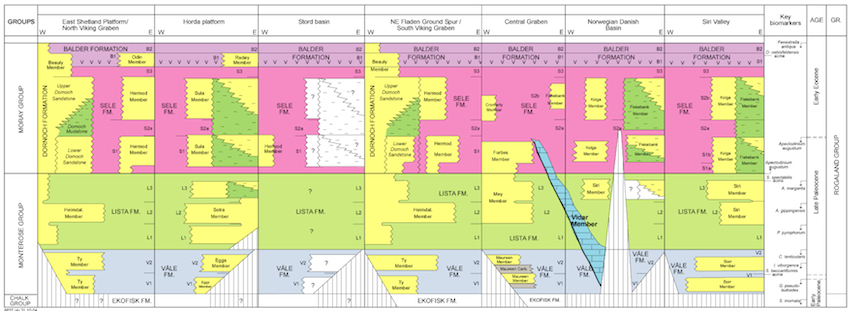
Fig. 140: Inferred stratigraphic development and position of the Vidar Member, as a part ofВ an olistolith moving down slope from the SГёrvestland High during the Thanetian-Ypresian transition. |
The former Vidar Formation (now Vidar Member) was named by Hardt et al. (1989).
The lithostratigraphic unit is named after one of Odin’s sons Vidar.
Hardt et al. (1989) defined the interval 3138-3075m RKB in well 2/1-4 (Figure 141) as the type section for the former Vidar Formation, here classified as Vidar Member. In this well the Vidar Member directly overlies the Lista Formation.
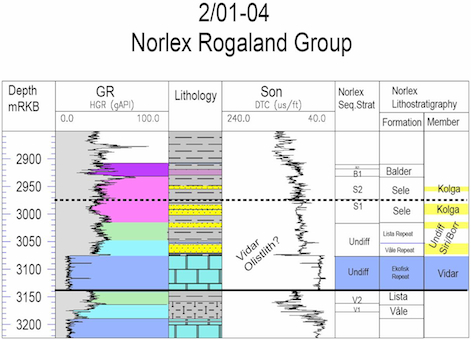
Fig. 141. Logs from well 2/1-4: 3138-3075m; stratigraphic position of the Vidar Member outlined. |
Hardt et al. (1989) defined well 1/3-1, 3147-3095m RKB as reference well and reference section for the Vidar Member (Figure 142). In this study we include well 1/3-5, 3152-3202m RKB as a second reference well (Figure 143). In both these well sections the Vidar Member directly overlies the Sele Formation.
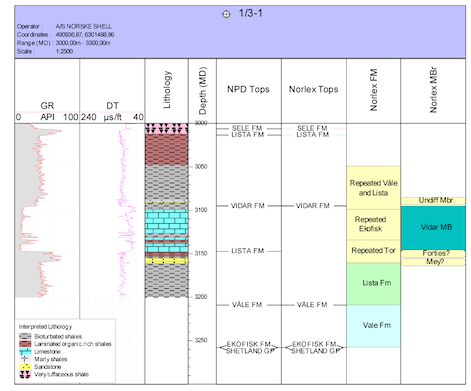
Fig. 142. Logs from well 1/3-1: 3147-3095m; stratigraphic position of the Vidar Member outlined. |
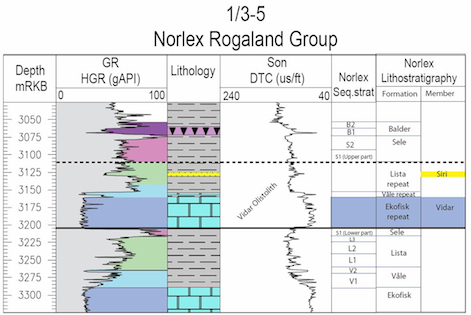
Fig. 143. Logs from well 1/3-5: stratigraphic position of the Vidar Member outlined. |
Through biostratigraphical analysis in connection with Dreyer et al.’s (2004) study (Figure 144) it was demonstrated that the high gamma peak deposits seen from the well logs below the Vidar Member contains typical intra-Sele microfossils.
From seismic the Vidar chalk is easily mappable as a generally continuous seismic hard event internally in the Rogaland Group (Figure 145). The basal part of the chalk can also often be mapped, and is a marked soft event.
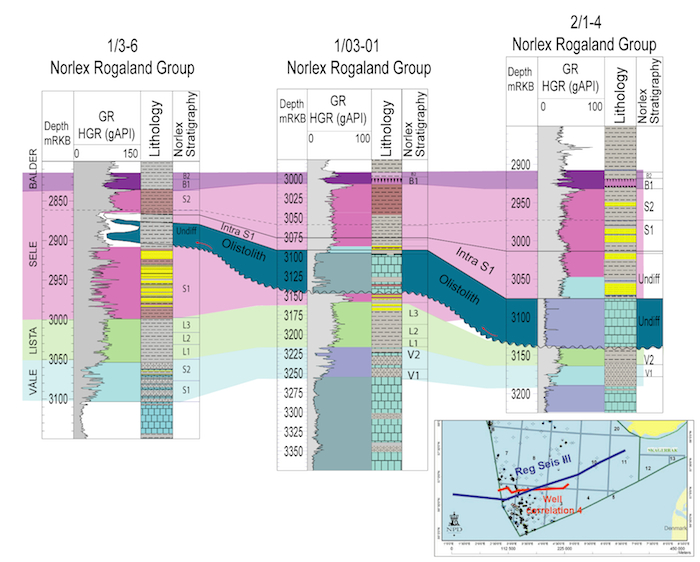
Fig. 145: Well correlation chart showing preferred depositional model for the Vidar Member olistolith (insert is part of location map in Figure 32, correlation line 4). |
In the west the chalk lithologies of the Vidar Member appear to onlap the Forties Member (Figure 146). In its central parts the Vidar chalk occurs in lower to middle parts of the Rogaland Group. Towards the east it dives downwards into the lower parts of the Rogaland Group before it seems to lap onto the top Shetland Group.
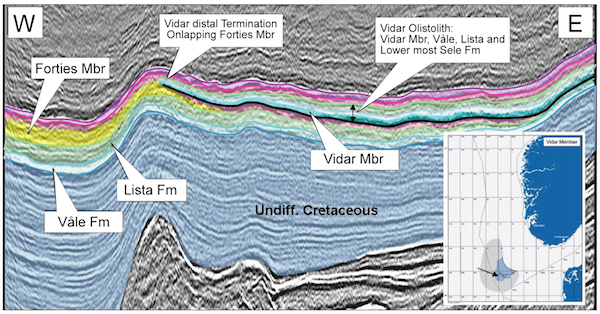
Fig. 146: Western parts of the Vidar Member, showing the climbing/crosscutting of stratigrapy and the ponding against top of the Forties Member.
|
Further east it is difficult to distinguish from the top Shetland Group, and is probably absent (Figure 147). East of this there is a marked cliff feature that cuts lithologies belonging to upper parts of the Shetland Group, as well as the VГҐle and Lista formations and possibly the lower parts of the Sele Formation.
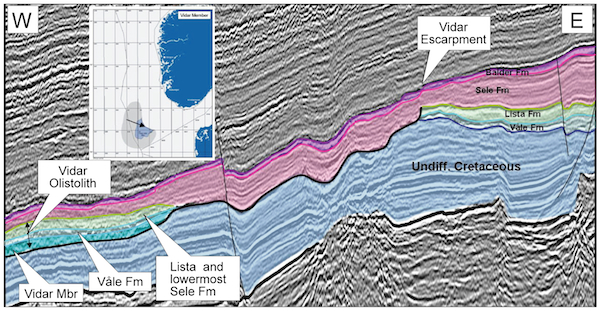
Fig. 147. Eastern slump scar, where the Vidar olistolith originated. To the East (right) is indicated which lithostratigraphic units slumped. |
Exact dating of the Vidar Member is not straightforward, since the Vidar Member itself contains Maastrichtian to Danian chalk fossils, and the shales above and below vary much in age. In well 1/3-1 strata on top of the Vidar Member vary in age but are mostly Selandian to Thanetian.
Strata immediately below the Vidar Member vary in age from Danian (well 7/12-10) to early Ypresian (well 1/3-1). The variable age dating of lithologies above and below the Vidar Member is considered to be an expression of re-deposition of youngest Ekofisk and oldest Rogaland strata.
In order to provide more systematic biostratigraphic and chronostratigraphic information on deposits belonging to the Vidar Member and its ‘envelope’, core samples were obtained from well 1/3-7, and cuttings samples from wells 1/3-5 and 2/1-4. On these samples nannofossil and organic microfossil analysis were performed, respectively by J. Lees (London, UK) and D. Munsterman (Utrecht, The Netherlands).
The results are summarized below.
The nannofossils taxonomy and zonation follow Burnett et al. (1998) and Varol (1989, 1998); the palynology zonation is that of D. Munsterman, using Gradstein et al. (2005) and unpublished information used by TNO for routine palynology of North Sea well samples.
Well 1/3-7
Three core samples were analyzed of well 1/3-7 at 3164.1, 3164.6 and 3177.1m to provide insight in the age of the youngest samples overlying the Vidar Member (cf. Dreyer et al. 2004) (see Figure 148).
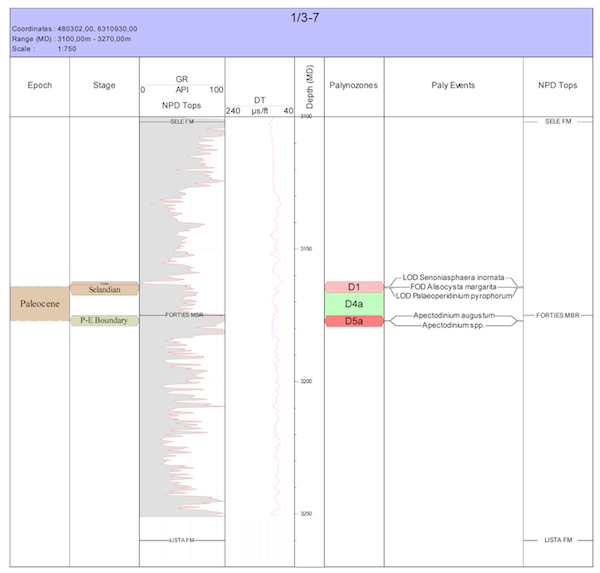
Fig. 148. Palynological results for Well 1/3-7. |
| Depth (m) | Type | Age | (Sub)Zone |
| 3164.1 | CO | Danian | D1 |
| 3164.6 | CO | Selandian | D4a |
| 3177.1 | CO | IETM | D5a |
Core sample 3164.1m is assigned a Danian age (Zone D1) based on the dinoflagelate Senoniasphaera inornata, but specimens may have been reworked into Selandian strata if weight is given to the presence of Palaeoperidinium pyrophorum.В Alternatively, the latter could have been reworked also.
Core sample 3164.6m is assigned a Selandian age (Zone D4a), based on the presence of Alisocysta margarita and Palaeoperidinium pyrophorum.
Core sample 3177.1m contains the acme of Apectodinium spp. and up to 15% of Apectodinium augustum typical for the Initial Eocene Thermal Maximum (IETM) of Early Ypresian, earliest Eocene age. The relatively large numbers (24% of the total sum dinocysts) of the genus Palaeoperidinium are considered to be reworked from Selandian or older successions.
The sporomorphs comprise ca. 50% of the total sporomorph and dinocyst sum at sample depth 3177.1m. The genus Apectodinium constitutes of 45% of the total sum of insitu dinocysts. The conditions are interpretated to reflect a coastal marine depositional setting.
The Paleocene/Eocene Thermal Maximum (or Initial Eocene Thermal Maximum or Eocene Thermal Maximum 1), ~55.5 Ma ago, was marked by a sudden global warming event and associated with changes in oceanic and atmospheric circulation. The event is linked to a negative excursion in the Оґ13C isotope record. The global temperature rose ca. 6 В°C over 20 ka, and is associated with a world-wide sea level rise (Sluijs et al. 2006).
The above analysis is in good agreement with the results of Dreyer et al. (2004) that the youngest deposits overlain by the Vidar Member are earliest Eocene in age.
Well 2/1-4
In well 2/1-4 two cuttings samples at 2900 and 2920m were processed and analyzed for nannofossils, and five cuttings samples at 2900, 2920, 3030, 3100 and 3190-3200m for palynology (see Figure 149 for results).
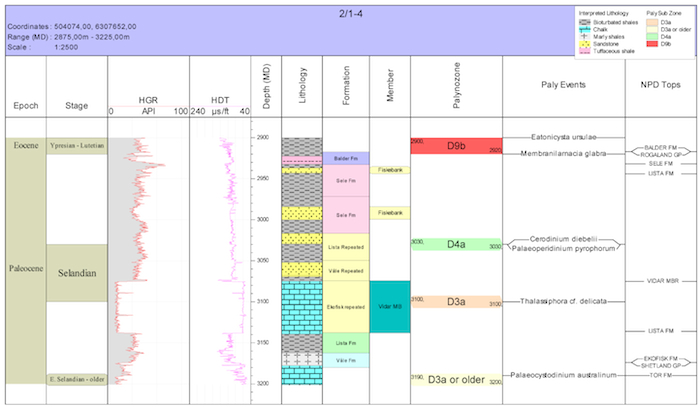
Fig. 149. Palynological results for Well 2/1-4. |
The Cretaceous nannofossil component is assigned to zones UC20cBP to UC20dBP (Upper Maastrichtian), based on the presence of Arkhangelskiella maastrichtiensis and Cribrosphaerella daniae, respectively. Sample 3100m contains a greater diversity of Cretaceous taxa than 3200m (33 species), including Reinhardtites levis (which has a last stratigraphic occurrence in the Lower Maastrichtian), and indicates a reworked Cretaceous component at 3100m. The Paleogene nannofossils are again characteristic of mid Danian to Early Selandian age strata (NP3–NP5), as observed also in the core samples of well 1/3-7.
The palynological results are summarized below:
| Depth (m) | Type | Age | (Sub)Zone |
| 2900 | CU | Ypresian-Lutetian Boundary | D9b |
| 2920 | CU | ||
| 3030 | CU | Selandian | D4a |
| 3100 | CU | D3a | |
| 3190 - 3200 | CU | Early Selandian or older | D3a or older |
Cuttings samples 2900m and 2920m are assigned to the D9b subzone across the Ypresian–Lutetian boundary, based on the presence of Eatonicysta ursulae in the higher sample and Membranilarnacia glabra in the lower one. Areoligera gippingensis is interpreted as reworked from Thanetian strata, and carbonized sporomorphs such as Classopollis from the Mesozoic, and Lycospora from the Carboniferous.
Cuttings sample 3030m contains Palaeoperidinium pyrophorum and Cerodinium diebelii assigned to subzone D4a, Selandian. Thalassiphora cf. delicata was found in sample 3100m in the Vidar Member strata, and is assigned to subzone D3a, early Selandian.
Cuttings sample 3190-3200m contains two distinct lithologies that were analyzed separately. The red-brown shale chips are dominated by Areoligera gippingensis. This association is considered caved from an Upper Selandian–Lower Thanetian level (D4b dinocyst subzone sensu Gradstein et al. 2005). The assemblages from the greyish chalk part of the cuttings, including Palaeoperidinium pyrophorum and Spinidinium densispinatum, confirm an age in the Selandian or older successions. Note that the taxon Areoligera gippingensis is absent in the greyish chalky part of the same sample. The presence of Palaeocystodinium australinum constrains the dating at sample depth 3200m. В В
The new biostratigraphy in well 2/1-4 indicates a Late Danian through Early Selandian resting place for Vidar strata, in itself containing Maastrichtian strata. The top Ekofisk Formation is assigned a Danian–Early Selandian age.
Well 1/3-5
Five cuttings samples were processed for nannofossils and palynology in well 1/3-5 (Figure 150).
The Cretaceous nannofossil component is from subzone UC20cBP (Upper Maastrichtian), based on the presence of Arkhangelskiella maastrichtiensis, or UC20dBP (Upper Maastrichtian), based on the presence of Cribrosphaerella daniae. No Paleogene-restricted taxa were found in Vidar unit sample 3175m, only above Cretaceous and K/T survivor taxa. The presence of common Prinsius martinii and Neocrepidolithus fossus indicates NP3–NP4 (mid Danian to Early Selandian) in the two samples below this.
Palynological results are summarized below.
| Depth (m) | Type | Age | (Sub)Zone |
| 3022 | CU | Lutetian | D9e |
| 3052 | CU | Ypresian-Lutetian Boundary | D9b |
| 3175 - 3256 | CU | Selandian | D3b |
| 3268 | CU | Early Selandian | D3a |
| 3289 - 3301 | CU | Early Selandian or older | D3a or older |
Sample 3022m is assigned to subzone D9e, Lutetian, based on Areosphaeridium ebdonii, Diphyes ficusoides, Hystrichosphaeridium tubiferum and Phthanoperidinium clithridium. Reworking of Jurassic–Lower Cretaceous origin, e.g., the genera Callialasporites and Ischyosporites, is recorded.
Sample 3052m is assigned to subzone D9b, Ypresian/Lutetian, based on the presence of Eatonicysta ursulae, and sample interval 3175-3256m to subzone D3b based on Spinidinium densispinatum, Selandian. The latter interval is in the Vidar Member. The cuttings at depth 3175m include a morphotype with two specimens with affinity to Chatangiella; this genus indicates a Late Cretaceous age.
The Vidar Member seems to extend within the LV1, LV2 and LV3, S1 and possibly S2? areas (Figures 151, 152)
The Vidar Member is present in the area west of what we here define as the Vidar escarpment, over an area of more than 500km2 in Quadrants 1, 2, 3 and 7, 8 and 9 (Figure 151).
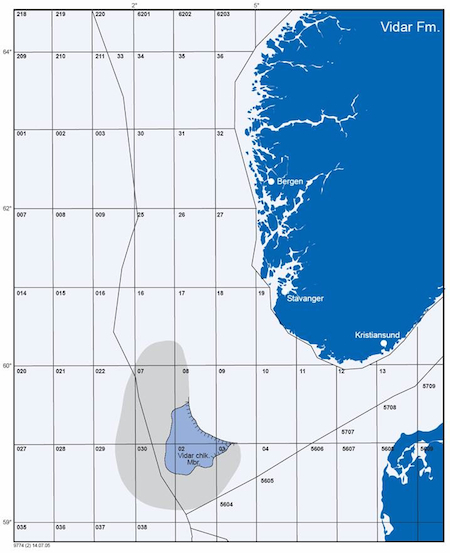
Fig. 151. The Vidar Member is present in the area west of what we here define as the Vidar escarpment, over an area of more than 500km2 in Quadrants 1, 2, 3, and 7, 8, 9. |
The chalky and marly mudstones of the Vidar Member are interpreted to represent reworked chalk of the uppermost part of the Shetland Group and the VГҐle Formation.В Exact timing and depositional process is not completely resolved, but this study narrows the options.
At present our preferred model is that the Vidar Member represents olistolithic slides that happened during short periods, perhaps as a series of mega slides. This involved movement of slide blocks consisting of a basal chalk body and the overlying siliciclastic lithologies of the VГҐle, Lista and lowermost Sele formations. The non-presence of VГҐle Formation, and possibly also the absence of the Lista Formation in well 2/2-2, is interpreted to represent rafting away of lithologies of Upper Shetland Group together with VГҐle, Lista and possibly lower parts of the Sele formations.В
The provenance of the Vidar Member with its chalk and overlying lithologies seems to have been the SГёrvestlandet High, and we believe that the steep cliff feature seen in seismic data east of the Vidar Member distribution area reflects the proximal collapse scar of the olistolith (Figure 152).
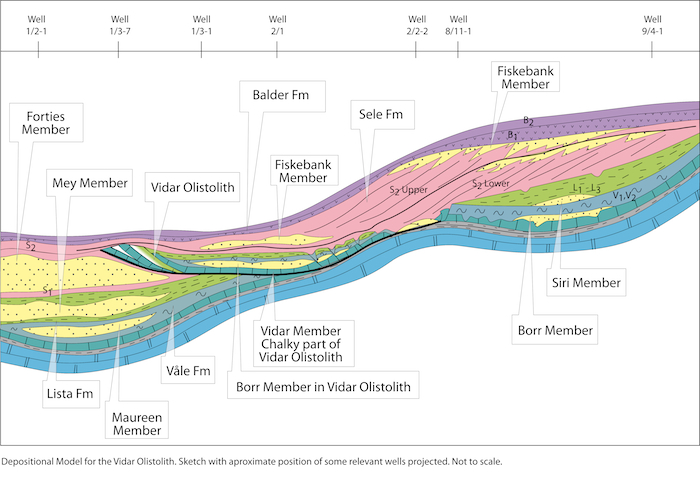
Fig. 152. Depositional model for the Vidar olistolith: the correlation sketch shows approximate position of relevant wells projected; not to scale. |
Mapping of the chalk lithologies in Vidar Member
In seismic data, the base of the Vidar is difficult to separate from the Shetland Group, in the areas close to the Vidar escarpment. We believed that this can be explained partly by translational movements and the non-presence of the slide close to the escarpment, with younger sediments directly overlying the former basal shear plane.
In the proximal parts of the olistolith the shear plane is believed to have been along bedding planes within the chalk. Further west towards the Central Graben, the basal shear plane climbs in the stratigraphy, cutting the VГҐle, Lista and eventually the Sele Formations.В
Timing of the Vidar Member
Mapping of the inferred olistolith, and age dating of Vidar and 'envelope' strata show that the youngest lithology overlain by the olistolith is Early Ypresian in age. This indicates that olistolithic failure and redeposition went on until this time. It may have started in (Late) Selandian time. The post-sedimentary process locally displaced on almost complete Paleocene succession down-flank from east to west.No hydrocarbon discoveries have been made in the Vidar Member.
| home | previous page |